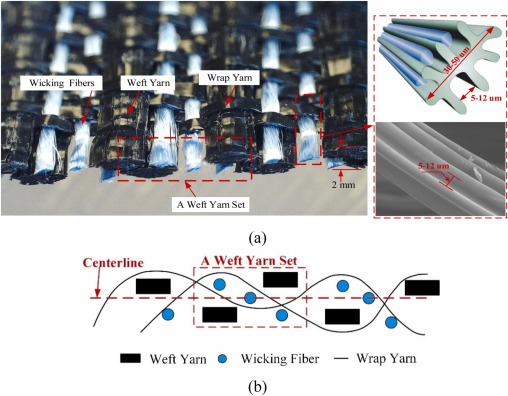In the world of sportswear design, understanding how fabrics transport sweat is crucial for ensuring comfort during physical activity. A recent study examined the wicking behaviors of elastic yarns under conditions mimicking human perspiration, revealing new insights into their performance in managing moisture. This research breaks ground by closely analyzing various yarn structures under realistic, finite droplet conditions, thereby advancing the design of high-performance athletic garments.
Importance of Liquid Transport in Fabrics

Maintaining a core body temperature of approximately 36 to 38 degrees Celsius is essential for normal physiological function. When temperatures rise, human sweat glands activate, necessitating effective fabric design that allows sweat to evaporate from the skin through the garment’s layers. The capillary action, or spontaneous liquid flow within yarns and fabrics, primarily drives this process, which is influenced by a variety of factors, including material properties, yarn structure, and environmental aspects.
Water absorption and transport capabilities are particularly crucial in close-contact sportswear. Synthetic fibers, celebrated for their excellent capillarity, are routinely utilized in these garments to efficiently manage both vapor and liquid sweat. Elastic fibers have garnered attention for their role in enhancing muscle oxygen uptake and minimizing lactate levels during strenuous activity. Despite numerous studies examining the wicking performance of textiles, finite droplet conditions reflecting actual human perspiration have been largely overlooked.
Previous Research and Methodology

Existing studies have largely focused on the wicking behavior of fabrics under conditions of infinite liquid supply. Researchers, including Wang et al., have explored the effects of yarn tension and twist on moisture absorption under different conditions of stretching. However, a clearer understanding of liquid transport mechanisms within yarn structures remained elusive, especially concerning interactions during stretching states. Researchers like Kim et al. have formulated methods to simulate human perspiration, but systematic investigations directly measuring the wicking behaviors of different yarn configurations under conditionally finite droplet settings were lacking.
To fill this gap, the recent study developed an experimental platform designed to closely mimic the microdroplet perspiration of humans. Using this setup, the study comprehensively analyzed the wicking performances of various polyester elastic yarns, including single and plied yarns, across different levels of stretching. Researchers specifically investigated how stretching affects yarn structure and its resultant impact on moisture management capabilities.
Key Findings on Wicking Mechanics

The study uncovered compelling relationships between the stretching states of elastic yarns and their wicking efficiencies. When the yarns were stretched, an observable reduction in both yarn and average hydraulic diameters took place. Interestingly, moderate stretching enhanced wicking lengths for both single and plied yarns, although a peak wicking value was reached beyond which the performance declined.
Moreover, heightened twist levels combined with increased stretching correlated with a reduction in the initial wicking rates of plied yarns. Conversely, incorporating more plies appeared to alleviate the adverse effects associated with both higher twist and stretching. Notably, the wicking length of plied yarns generally surpassed that of single yarns, establishing a strong positive correlation between the two, supporting the notion that structural configuration heavily influences performance.
From a theoretical standpoint, the Lucas-Washburn equation—frequently utilized to predict capillary flow—showed significant applicability in predicting the wicking behavior of yarns under finite droplet conditions, reliant on the average hydraulic diameter and droplet volume. Disparities were noted, particularly in terms of liquid transfer, as the stretch differences between various yarn types affected moisture movement adversely.
Insights into Liquid Transport Dynamics
As the research progressed, it became evident that liquid preferentially diffuses along yarns under lower stretch states before penetrating interlacing points within the yarn structure during higher stretch conditions. Further findings indicated that increasing the stretch differential between warp and weft yarns restricted the transfer of liquid from tightly stretched yarns to those experiencing less tensile force, underlining the intricate dynamics governing moisture transference within interlaced networks.
Through comparative experimental and theoretical analyses, the study not only elucidated the fundamental mechanisms of moisture transport in elastic yarns but also reinforced the need for a deeper focus on yarn-level behavior in textile applications, especially for elastic sportswear.
Conclusion of Findings
This pivotal research sheds light on the intricate connections between yarn structure, stretching states, and the wicking performance of elastic yarns under finite droplet perspiration conditions. By systematically analyzing various factors—including yarn fineness, twist, number of plies, and average hydraulic diameter—the findings provide crucial support for future research and development in textile engineering. Insights gained could facilitate improvements in the structural optimization and functional design of high-performance athletic wear, enhancing overall performance and comfort for athletes.
With this new knowledge, designers and manufacturers of activewear can now apply these principles to create more effective and comfortable textiles that meet the demanding conditions of human perspiration during physical activities.



